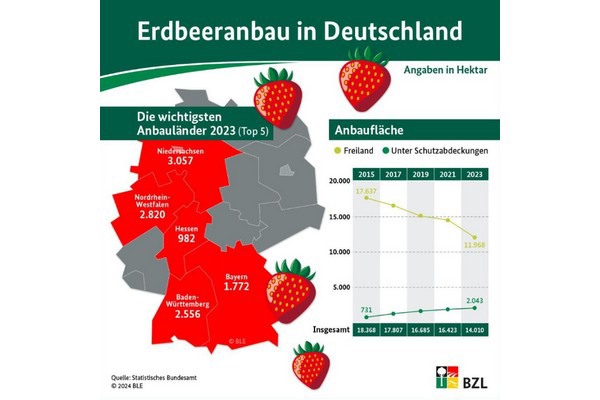The strawberry cultivation area in Germany has significantly decreased over the past few years. In 2023, strawberries were cultivated across a total of 14,010 hectares – marking a decline of almost a quarter compared to 2015. This is primarily due to the substantial reduction in open-field strawberry production (-5,669 hectares compared to 2015).
Conversely, cultivation under protective covers has seen an increase (+1,312 hectares compared to 2015). Here, yields per hectare are nearly twice as high as those in open fields. The leading strawberry-producing regions are Lower Saxony, North Rhine-Westphalia, and Baden-Württemberg, with these three states accounting for around 60 percent of the total cultivation area.

According to figures from the GfK household panel, every private household consumed a total of 4.13 kg (2022: 4.34 kg) of the sweet fruit, with 2.09 kg (2022: 2.12 kg), or just about 51 percent, originating from German cultivation. The self-sufficiency rate in 2023 was 53.4 percent, slightly higher than in 2022 (52.9 percent), which according to the Agricultural Market Information Company (AMI), can be attributed to a significant decline in imports. A high self-sufficiency rate in strawberries contributes actively to sustainability and environmental protection, due to the short transportation distances and the availability of water in the main German strawberry-growing regions.
A glimpse into the strawberry strongholds:
In the Palatinate, the first Pfalzmarkt producers began harvesting early strawberry varieties in tunnel cultivation in mid-April. Since these were relatively small harvest volumes initially, they primarily reached consumers through direct marketing. From calendar week 18 onwards, larger quantities become available, enabling supply to wholesale markets and the nationwide retail food industry with fresh strawberries from the Palatinate. Joachim Leonhardt, from the sales team at Pfalzmarkt eG explains: "The weather in spring was optimal for the growth of the strawberries, and this year we are about ten days ahead of previous years, currently expecting a good to very good harvest!" The classic strawberry season at Pfalzmarkt eG runs from April to July. A new trend is everbearing varieties. These special strawberry cultures can be harvested up until October. In the pre-season, the last delivery of strawberries was recorded at Pfalzmarkt eG at the end of October 2023.
Further north, the mood is also excellent. "We have been marketing the first German strawberries from protected cultivation just before Easter, with larger harvest volumes expected from mid-April. At the end of April, we start marketing fresh regional strawberries from tunnel cultivation in the Rhineland. And as long as the weather continues to cooperate, the open-field strawberry season in the west will kick off about two weeks later," explains Arthur Heinze, Sales Manager for Fruit at Landgard Obst & Gemüse & Co. "As the retail sector increasingly focuses on regional products, the demand for German strawberries in the retail food industry has steadily risen over the last few years. It's clear, freshly harvested from the field, the berries simply taste best."
For more information:
www.pfalzmarkt.de
www.landgard.de
www.deutsches-obst-und-gemuese.de
